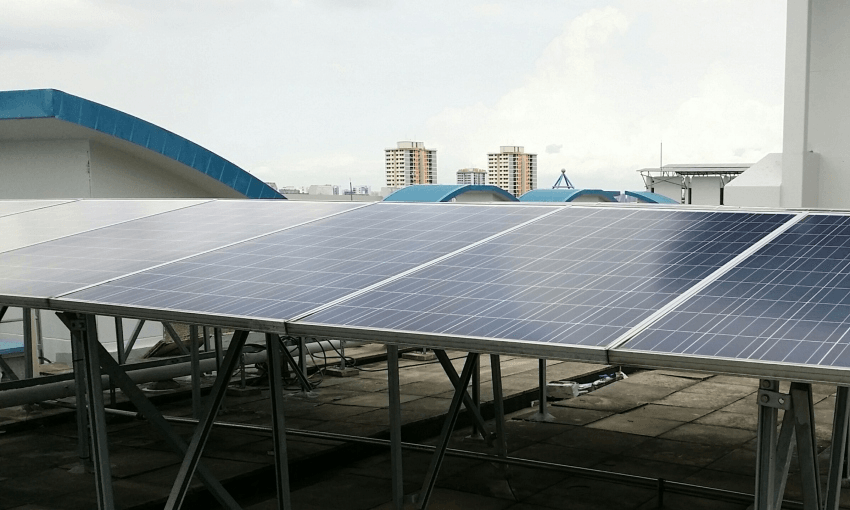The pros and cons of putting solar panels on the roof of your home are well debated. But what about the empty rooftop spaces on commercial buildings throughout our country? PowerSmart’s Sam Vivian explains why more New Zealand businesses are adding commercial solar systems to their buildings.
There are two facts of life in business that never change: it matters a) what your customers think of you, and b) how much money falls to the bottom line. While I’m certainly not advocating for green-washing, there are instances where being sustainable with an aim to save money can work – in particular, solar electricity in a business.
Solar power as an electricity source can make so much sense in a commercial context. When it’s generated locally, it means you don’t have to pay the cost of transporting it from a generation site somewhere down the country. New Zealand also has good sunshine hours and what as we say in the industry a ‘great solar irradiance’ – basically, the sun shines nice and strong here (you only need a day at the beach without sunscreen to tell you that!)
Also, while our energy is a good mix of hydro, wind, and geothermal generation, solar electricity has its part to play as we become more power hungry as a nation. If we are going to achieve the Government’s ambitious target of 100% renewable electricity by 2035, we can’t be complacent in how we’re going to get there.
The vast amount of un-utilised roof space in New Zealand is a good place to start for one simple reason: solar panels generate electricity during the day, at exactly the time when most businesses need it. Because of that, there is no need to install batteries – which are often the expensive bugbear of home or business owners considering the switch to solar. As installations of solar skyrocket globally there has been a continued reduction in the price of the equipment needed, like solar panels and inverters. Getting it up and running is relatively easy as well. All it takes is a matter of weeks; it can be dovetailed with existing infrastructure; and the reduced consumption of grid electricity (along with the associated carbon emissions from its generation) is immediate and measurable.
Some businesses may have been feeling the pinch as a result of recent volatility in electricity spot prices, but another benefit of solar is that the cost of generating electricity is not affected by the cost of retail power prices.
What’s more, carbon prices under New Zealand’s Emissions Trading Scheme may be capped for now, but are forecasted to increase significantly in the next decade to encourage more widespread efforts to curb emissions. Rather than waiting to be hit in the pocket by higher carbon prices or a carbon tax, solar electricity could be a good option to avoid that mess in the future.
Finding the capital to fund a new solar electricity system can be one of the biggest roadblocks to installing commercial solar systems, but there are options available to avoid having to stump the cash upfront.
The latest acronym to hit commercial solar jargon is a ‘PPA’ (Power Purchase Agreement) – an agreement to purchase all the power generated from a solar electricity system for a fixed rate over a certain period of time (between 10-20 years). The system itself is owned, operated and maintained by PowerSmart during the term of the PPA and then transferred to the business for free at the end of the term where it can continue to generate renewable electricity for the business.
The first business to sign up to a PPA was Yealands Winery in Marlborough where the largest solar electricity system in New Zealand supplies on average almost 30% of the winery’s energy needs. There are many other successful examples of commercial solar in New Zealand including the public library in Ranui; shopping malls in Auckland (Sylvia Park) and Whangarei (Tarewa Mega Mall); Otuwhare Marae on the East Cape; a couple of schools on Auckland’s North Shore; a dairy farm in Waikato; and more.
Some business and building owners still sometimes think solar electricity is too hard or too expensive, but there are environmental, community, and even marketing benefits in making the move. The paybacks exist in the kudos from your customers and community for committing to the environment, and financially businesses can find themselves better off too.
San Vivian is a Business Development Manager at PowerSmart, which has installed seven of the ten largest solar installations in New Zealand and completed a number of large solar and battery installations across the Pacific.
This content was created in paid partnership with Vector. Learn more about our partnerships here.
This content is brought to you by Vector. If you live in Auckland, they also delivered the power you’re using to read it. And they’re creating a new energy future for all of us, as showcased by the incredible Vector Lights in partnership with Auckland Council.
